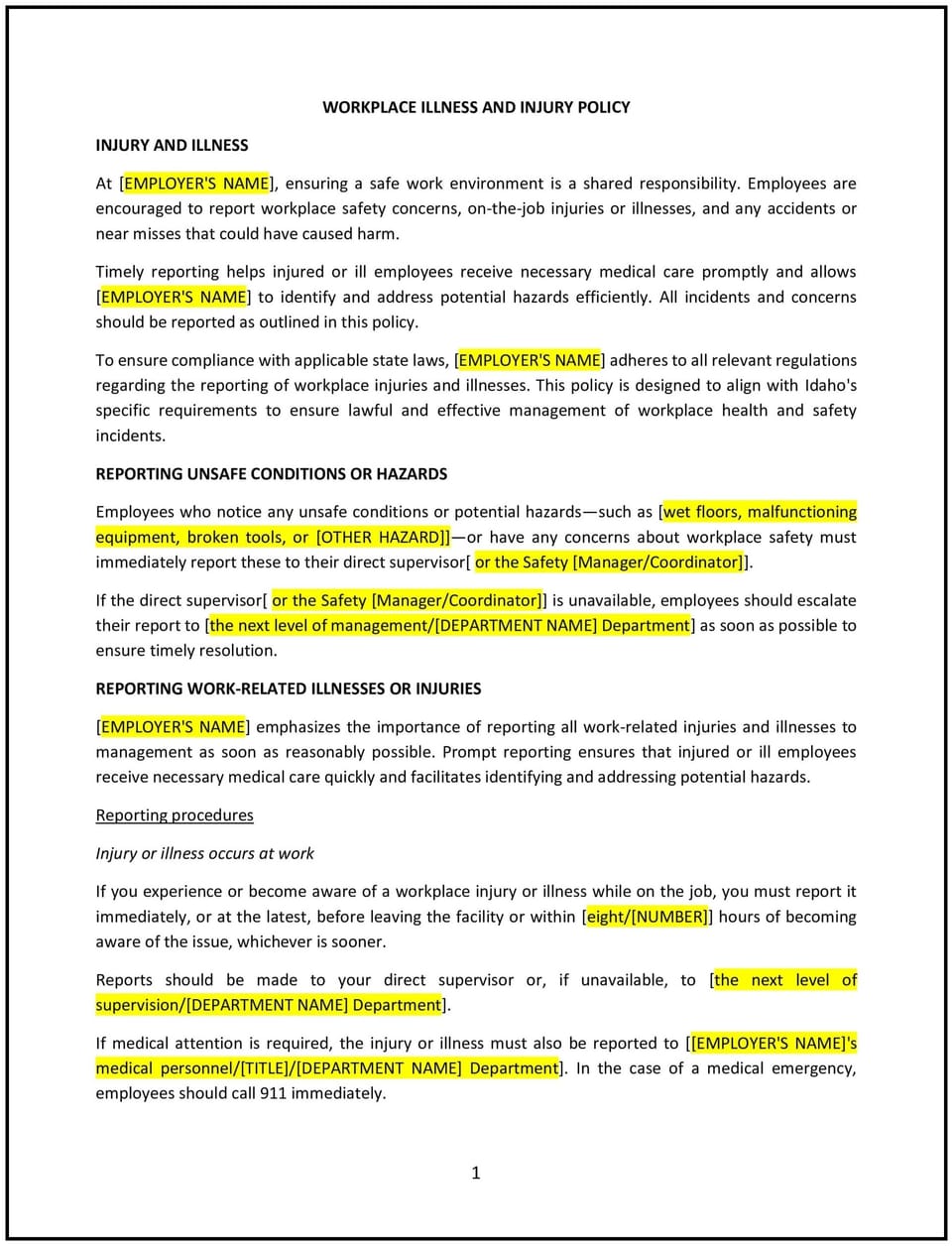Workplace illness and injury policy (Idaho): Free template

Workplace illness and injury policy (Idaho)
A workplace illness and injury policy helps Idaho businesses establish guidelines for managing employee health and safety incidents. This policy outlines procedures for reporting illnesses and injuries, providing medical care, and facilitating a safe return to work. It also emphasizes the importance of maintaining a safe work environment and supporting employees during recovery.
By implementing this policy, businesses can protect employee well-being, reduce workplace risks, and ensure compliance with health and safety standards.
How to use this workplace illness and injury policy (Idaho)
- Define reporting procedures: Specify how employees should report workplace illnesses and injuries, including timelines, required documentation, and designated contacts.
- Address medical care: Outline the steps for providing immediate medical care, such as first aid or emergency services, and coordinating with healthcare providers.
- Facilitate return to work: Explain the process for supporting employees’ return to work, including modified duties, accommodations, or gradual reintegration.
- Promote prevention measures: Include guidelines for preventing workplace illnesses and injuries, such as safety training, hazard assessments, and ergonomic improvements.
- Train employees: Provide training for employees on how to recognize and report hazards, follow safety protocols, and respond to incidents.
- Train managers: Equip managers with the skills to handle illness and injury reports, maintain confidentiality, and support employees during recovery.
- Review and update the policy: Periodically assess the policy’s effectiveness and make adjustments based on changes in business needs, employee feedback, or Idaho laws.
Benefits of using this workplace illness and injury policy (Idaho)
This policy offers several advantages for Idaho businesses:
- Protects employee well-being: Clear guidelines help ensure employees receive prompt medical care and support during recovery.
- Reduces workplace risks: The policy promotes a culture of safety, minimizing the likelihood of illnesses and injuries.
- Enhances productivity: A safe and healthy work environment contributes to higher employee morale and productivity.
- Supports compliance: The policy helps businesses adhere to Idaho and federal health and safety regulations, reducing the risk of legal penalties.
- Encourages accountability: Clear expectations and procedures help employees and managers understand their responsibilities in maintaining a safe workplace.
- Fosters a culture of safety: The policy reinforces the business’s commitment to prioritizing employee health and safety.
Tips for using this workplace illness and injury policy (Idaho)
- Communicate the policy clearly: Share the policy with employees during onboarding and through internal communication channels to ensure awareness and understanding.
- Train employees: Provide training on how to recognize and report hazards, follow safety protocols, and respond to incidents.
- Train managers: Equip managers with the skills to handle illness and injury reports, maintain confidentiality, and support employees during recovery.
- Monitor compliance: Regularly review workplace safety practices and address any potential issues promptly to ensure adherence to the policy.
- Encourage transparency: Foster a culture where employees feel comfortable reporting illnesses, injuries, or safety concerns without fear of retaliation.
- Document everything: Maintain records of incident reports, medical care, and return-to-work plans to ensure accountability and transparency.
Q: Why should Idaho businesses have a workplace illness and injury policy?
A: A workplace illness and injury policy provides clear guidelines for managing health and safety incidents, protecting employee well-being, and maintaining a safe work environment.
Q: What steps should employees take to report workplace illnesses or injuries?
A: Employees should follow the reporting procedures outlined in the policy, including notifying a designated contact, providing required documentation, and seeking medical care if necessary.
Q: How should businesses provide medical care for workplace injuries?
A: Businesses should offer immediate first aid or emergency services and coordinate with healthcare providers to ensure employees receive appropriate care.
Q: What steps should businesses take to support employees’ return to work?
A: Businesses should provide modified duties, accommodations, or gradual reintegration plans to help employees return to work safely and effectively.
Q: How can businesses prevent workplace illnesses and injuries?
A: Businesses should implement prevention measures, such as safety training, hazard assessments, and ergonomic improvements, to minimize risks.
Q: What training should employees receive on workplace safety?
A: Employees should receive training on how to recognize and report hazards, follow safety protocols, and respond to incidents.
Q: How often should businesses review their workplace illness and injury policy?
A: Businesses should review the policy annually or as needed to ensure it aligns with current business needs, employee feedback, or Idaho laws.
This article contains general legal information and does not contain legal advice. Cobrief is not a law firm or a substitute for an attorney or law firm. The law is complex and changes often. For legal advice, please ask a lawyer.


